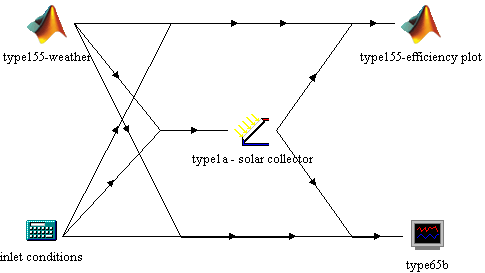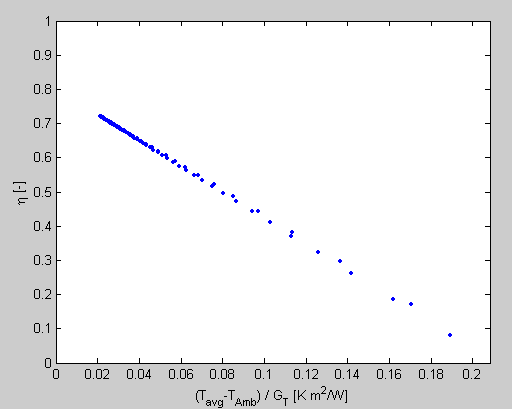TRNSYS - Matlab link example
Note: Before running this example, you
should modify your TRNSYS DLL to include Type155 and the required
Matlab libraries, as described in the Type155
manual.
This simple example illustrate the use of
2 Type155 units in a simulation. A simple solar collector (type1b) is
simulated with constant inlet conditions and daily sinusoidal ambient
temperature and solar radiation. A scatter plot of the collector
efficiency is then generated.
- The first unit (type155-weather)
generates a sinusoidal profile for ambient temperature and solar
radiation based on 3 constant inputs (minimum daily temperature,
maximum daily temperature and maximum daily solar radiation)
- The second unit (type155-efficiency
plot) will generate a scatter plot of the solar collector efficiency
versus (Tavg-Tamb)/G

Simulation parameters
- The minimum daily temperature is
set by input 1 of "type155-weather"
- The maximum daily temperature is set by input 2 of
"type155-weather"
- The maximum daily radiation (in
kJ/h/m²) is set by input 3 of "type155-weather"
- The solar collector parameters are
set to simulate high efficiency flat-plate collector (1m² area)
- Inlet conditions are set in the
equation block
Matlab routines
First
unit: Type155-weather
The first Type155 unit has mFileId set
to 1, so the following m-files are called by Type155:
- Very first call of the simulation:
type155initialize_001.m
- Iterative calls:
type155simulate_001.m
- Very last call of the simulation: type155terminate_001.m
ComponentKind is set to 0, which means
that Type155simulate_001.m will be called at each iteration of each
time step
ignoreEngClose is set to 0, so this routine allows Matlab to be closed
when TRNSYS exits
type155initialize_001.m
This routine just stores some information about the unit (nb of inputs,
outputs, etc.) and the simulation (nb. of time steps)
type155simulate_001.m
This routine generates sinusoidal
profiles for the ambient temperature and the solar radiation using
Tamb,min and Tamb,max and Gmax given by type 155 (respectively inputs
1, 2 and 3)
type155terminate_001.m
This routine is empty
Second
unit: Type155-efficiency plot
The first Type155 unit has mFileId set
to 2, so the following m-files are called by Type155:
- Very first call of the simulation:
type155initialize_002.m
- Iterative calls:
type155simulate_002.m
- Very last call of the simulation: type155terminate_002.m
ComponentKind is set to 10, which
means that Type155simulate_002.m will be called only once per time
step. The routine is actually called at the first iteration of a time
step with the stored inputs from last call, i.e. the converged inputs
from previous time step. This is useful for real-time controllers or
for plotting routines, as it is the case here.
ignoreEngClose is set to 1, so
this routine does not allow Matlab to be closed when TRNSYS exits. As
mentioned in Type155 parameters description, Matlab will keep running
after the TRNSYS simulation is done if at least one type 155 unit has
this parameter set to 1.
type155initialize_002.m
This routine stores some information about the unit (nb of inputs,
outputs, etc.) and the simulation (nb. of time steps). It initializes
the history variable, which will be used to store the inputs at each
call.
type155simulate_002.m
This routine stores the inputs in
the history variable.
type155terminate_002.m
This routine actually draws the
plot. It is called at the very last
call of the simulation, i.e. after the user presses the "yes" button in
the "exit online plotter?" window.
The values corresponding to solar radiation levels lower than 10
W/m² are ignored.
An example plot is given here below

Some TRNSYS-Matlab tips & tricks
Keeping history of inputs/outputs
As
always in Matlab, it is a good idea to create history-keeping variables
during the initialization call and fill them during the simulation
rather than increasing the size of a Matlab variable at each call. This
can have a very large effect on the speed of TRNSYS-Matlab simulations.
Troubleshooting m-files
- You
can use the Fortran debugger to step through type155 code in order
to diagnose prolems in Matlab (when the Fortran debugger stops at some
point in Trnsys, you can switch to Matlab and have a look at some
variables)
- Unfortunately,
the Matlab debugger is not supported in "Matlab Engine Application".
You can read article
29983 in the Matlab Solution Base for further information.
- A
very useful command is lasterr.
This command will tell you the last error that occurred in Matlab.
Typically, if an error occurs in an m-file called by Type155, you will
hear a series of beeps during the simulation and you will note that
some outputs will probably be set to -99999 by type155 (which occurs
when the "outputs" variable does not exist or is too short when Matlab
returns control to TRNSYS). If you set Type155 not to close the Matlab
instance when the simulation is done, you can switch to Matlab, type
"lasterr" and see information on the error that occurred
- It
is useful to test all m-files with fake input variables from TRNSYS (t,
inputs, info) to get rid of the most obvious syntax errors before
running them in TRNSYS. This can save you a lot of time and frustration.
Comments, Questions? Please contact trnsys@engr.wisc.edu
Michaël Kummert
Solar Energy Lab, UW-Madison
2003-06-25

